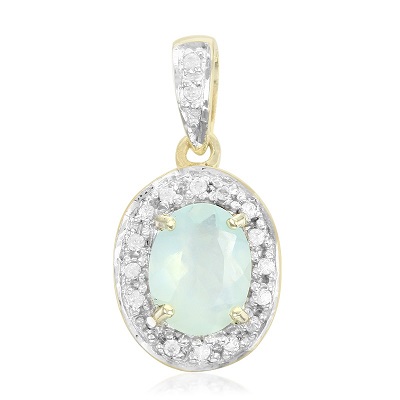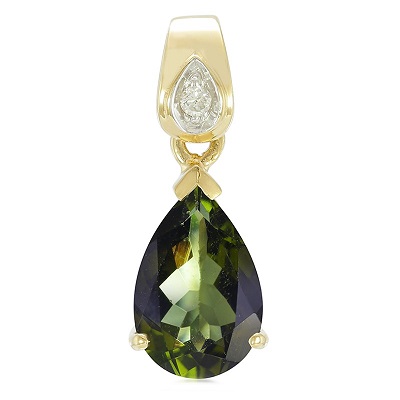Those born in the month of October have two birthstones to choose from, Tourmaline and Opal. Both gemstones come in a rainbow of shades and colour combinations.
The colour of Tourmaline depends on trace elements in its chemical makeup. Opal diffracts light, showing a play of multiple colours. Both stones, have been linked to a rainbow of myths and legends.

9k-paraiba-opal-gold-pendant Rocks & Co.
The gemstone name Opal originates from the Greek word, meaning to see a change in colour.
The Roman scholar Pliny used the word opalus when he wrote about this gem’s kaleidoscopic play of colour that could simulate shades of any stone, prompting the Romans to regard Opals as one of the most precious of all.
This characteristic of the gem was later explained in the 1960s when scientists discovered that opal is composed of microscopic silica spheres that diffract light to display various colours of the rainbow. Those without play-of-colour are common opals.
In Australia Opals are formed when seasonal rains soak the arid outback, carrying silica deposits underground into cracks between layers of rock. When the water evaporates, these deposits form opal. Sometimes, silica has seeped into spaces around wood, seashells and skeletons, resulting in opalized fossils. Although Australia has produced 95 percent of the world’s supply, Opal is also mined in Mexico, Brazil, Honduras, Ethiopia, the Czech Republic and parts of the U.S., including Nevada and Idaho.
The water content of opal can range from 3 to 21 percent – usually between 6 and 10 in a gem-quality material. This, combined with a hardness of only 5.5 to 6 on the Mohs scale, makes opal a delicate gem that can crack or “craze” under extreme temperature, dehydration or direct light, but wearing opal is well worth the extra care.
Although experts divide gem opals into many different categories, five of the main types are:
- White or light opal: Translucent to semi-translucent, with play-of-colour against a white or light grey background colour, called bodycolour.
- Black opal: Translucent to opaque, with play-of-colour against a black or other dark background.
- Fire opal: Transparent to translucent, with brown, yellow, orange or red body colour. This material—which often doesn’t show play-of-colour—is also known as “Mexican opal”.
- Boulder opal: Translucent to opaque, with play-of-colour against a light to dark background. Fragments of the surrounding rock, called matrix, become part of the finished gem.
- Crystal or water opal: Transparent to semi-transparent, with a clear background. This type shows exceptional play-of-colour. GIA
Myths & Legends
According to the Bedouins, opals fell from the sky in bolts of lightning. Australian Aborigines believed that the creator came to earth on a rainbow, leaving these colourful stones where his feet touched the ground.
Mark Anthony had his eye on a magnificent Opal that he intended for his beloved Cleopatra but its owner, a Senator named Nonius, preferred the rath of his leader and self-imposed exile, to parting with the stone.
During the Middle Ages, people believed that the opal possessed the powers of each gemstone whose colour appeared in its sheen, making it a very lucky stone.
The Power of negative Spin
Interestingly the publishing In 1829, of Sir Walter Scott’s book, “Anne of Geierstein,” transformed the gemstones image, for a time. The story featured an enchanted princess who wore an opal that changed colours with her moods. A few drops of holy water extinguished the stone’s magic fire, and the woman soon died. People began to fearfully associate opals with bad luck. Within a year after publication of Scott’s book, opal sales in Europe fell by 50 percent.
In the 1850s Queen Victoria influenced a turnaround in the popularity of Opals. The Queen kept an impressive personal collection and donned opals throughout her reign. Society closely watched the Royal British Court and opals soon became sought after around the world. This was coincidentally timed perfectly with a fine quality opal discovery in Australia.
Tourmaline is not one mineral, but a fairly complex group of minerals with different chemical compositions and physical properties. Tourmaline is desirable because of its sheer range of colour options. Combined with a hardness of 7 to 7.5 on the Mohs scale, tourmaline makes very wearable jewellery. Certain trace elements produce distinct colours, and many resulting varieties have their own names.
Facts, Myths & Legends of the Tourmaline
The word tourmaline comes from Sinhalese word turmali, which means “mixed.” Tourmalines exist in more colours and colour combinations than any other gemstone in the world. Perhaps this is why ancient mystics believed tourmaline could inspire artistic expression.
 Pink and green tourmalines are widely available and affordable. More expensive and rare tourmalines are blue indicolite, red rubellite, Paraiba (neon blues to greens) and an intense green tourmaline found in Kenya and Tanzania called chrome tourmaline. Tourmalines are most commonly found in Brazil, but also through Africa, the Middle East, and even in California and Maine in the United States.
Pink and green tourmalines are widely available and affordable. More expensive and rare tourmalines are blue indicolite, red rubellite, Paraiba (neon blues to greens) and an intense green tourmaline found in Kenya and Tanzania called chrome tourmaline. Tourmalines are most commonly found in Brazil, but also through Africa, the Middle East, and even in California and Maine in the United States.
Ancient magicians used black tourmaline as a talisman to protect against negative energy and evil forces. Today, many still believe that it can shield against radiation, pollutants, toxins and negative thoughts.
Egyptian lore tells of tourmaline finding its famed array of colours when, on its journey up from the earth’s centre, as it passed through a rainbow. Because of its colourful occurrences, tourmaline has been confused with other gems throughout history. In the 1500s, a Spanish conquistador found green tourmaline in Brazil—which he mistook for emerald. His error held until the 1800s when mineralogists finally identified tourmaline as its own mineral species.
Variations of the name “schorl” may have been used to describe black tourmaline even before 1400. The name comes from a village in Saxony, Germany, (now called Zschorlau) near a mine with black tourmaline deposits.
The Dutch East India Company brought Sri Lankan tourmaline to Europe for centuries before traders realized it was the same mineral as schorl.
American tourmaline deposits caused the gem’s spike in popularity. In 1876, mineralogist George Kunz launched a craze when he sold green tourmaline from Maine to Tiffany & Co.
In the early 1890s, tourmaline was reported in California—where Native Americans had, for centuries, given certain colours of the gem as funeral gifts.
At that point, China represented the biggest market for tourmaline. The Chinese Empress Dowager Cixi was particularly fond of pink tourmaline, and she purchased large quantities of it from deposits in San Diego County.
The Chinese market was so critical to tourmaline, in fact, that when the Chinese government collapsed in 1912, it took tourmaline trade down with it.
Brazilian tourmaline discoveries in the 1980s and 90s reignited interest in this gem because material mined in Paraíba displayed such striking neon greens, radiant blues and vivid violets.
References:
GIA: https://www.gia.edu/opal-description
GIA: https://www.gia.edu/gia-gem-project-tourmaline
WIKI: https://en.wikipedia.org/wiki/Tourmaline
WIKI: https://en.wikipedia.org/wiki/Anne_of_Geierstein





